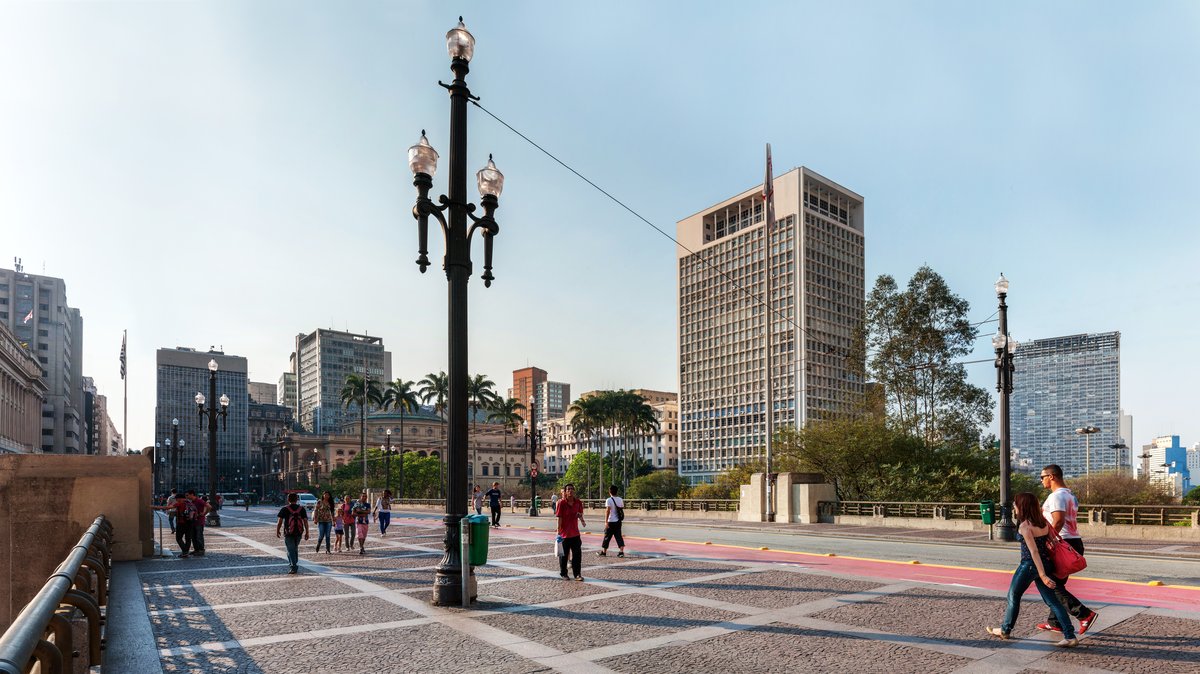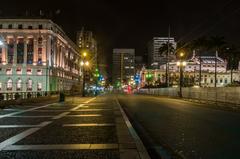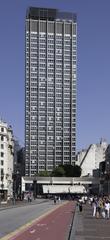
Viaduto do Chá: Visiting Hours, Tickets, and Complete Guide to São Paulo’s Historic Landmark
Date: 14/06/2025
Introduction
Viaduto do Chá is not only one of São Paulo’s most iconic architectural achievements but also a living symbol of the city’s dynamic history and cultural vibrancy. Spanning the Vale do Anhangabaú, this viaduct has connected the heart of the city since its inauguration in 1892, witnessing São Paulo’s transformation from a provincial town into a bustling metropolis. Whether you’re an architecture enthusiast, a history buff, or a curious traveler, this guide will provide all the essential information for visiting the Viaduto do Chá—covering its historical significance, practical visitor details, accessibility, nearby attractions, and tips for making the most of your experience (Garoa Histórica; Tourb).
History and Significance
Origins and Conception
Named after the tea plantations (Camellia sinensis) that once covered the Anhangabaú Valley, Viaduto do Chá was conceived in the late 19th century to solve the challenge of connecting São Paulo’s historic downtown with its rapidly expanding western neighborhoods. French entrepreneur Jules Martin initiated the project, and after years of planning and public debate, construction began in 1888. The viaduct was inaugurated on November 6, 1892, marking a milestone in São Paulo’s urban development (Viagem em Pauta).
Construction and Modernization
The original structure, built with iron imported from Germany, measured 240 meters in length and 6 meters in width. It quickly became a vital artery for pedestrians, carriages, and later electric trams. Increased traffic and the wear of time led to a major reconstruction in 1938, when the viaduct was rebuilt in reinforced concrete and expanded to 16 meters wide, incorporating Art Deco elements and improving its capacity and durability (São Paulo City Hall).
Urban Impact and Cultural Role
Viaduto do Chá’s construction united the “Centro Velho” (Old Center) and the “Centro Novo” (New Center), facilitating commercial growth and social integration. It has played host to a myriad of historic events, political demonstrations, parades, and cultural celebrations, cementing its status as both a practical connector and a civic stage (Lugares de Memória).
Architectural Features
The Viaduto do Chá is celebrated for its harmonious balance of functionality and style. Its balustrades, classic street lamps, and ironwork railings evoke the grandeur of early 20th-century São Paulo (Tourb). The current reinforced concrete structure, completed in 1938, reflects the city’s embrace of modernist engineering.
Distinctive features include panoramic viewing points, a suspended garden offering greenery and shade, and integrated lighting that dramatically illuminates the bridge at night. The viaduct is flanked by important architectural landmarks, such as the Theatro Municipal and the former City Hall, enhancing its historic ambiance.
Visiting the Viaduto do Chá
Location and How to Get There
Address: Viaduto do Chá, 15 – Centro, São Paulo, CEP: 01002-020
The viaduct connects Praça do Patriarca to Praça Ramos de Azevedo in São Paulo’s historic downtown (Prefeitura de São Paulo).
Public Transport:
- Metro: Anhangabaú (Line 3 – Red) and República (Lines 3 & 4) stations are within easy walking distance.
- Bus: Numerous lines serve the area.
- On Foot: The area is highly pedestrian-friendly.
Driving: Parking is limited in the city center; public transport or ride-hailing is recommended.
Visiting Hours
Viaduto do Chá is a public urban space and is accessible 24 hours a day, seven days a week (Guia da Semana). For the best experience, visit during daylight hours (8:00 AM – 6:00 PM), when the area is most active, shops and attractions are open, and the surroundings are liveliest.
Tickets and Entrance Fee
There is no entrance fee or ticket required to visit. Access to the viaduct is completely free.
Accessibility
The viaduct is wheelchair accessible, with ramps and level sidewalks at both ends. Public transportation stations nearby (Anhangabaú and República) are equipped with elevators and escalators. The area is suitable for those with limited mobility and for families with strollers (Go Ask a Local).
Safety Tips
- Daytime: The area is generally safe. Stay aware of your belongings, especially in crowds.
- Nighttime: After dark, foot traffic decreases; avoid walking alone and use well-lit, busy streets (Brazil Offbeat).
- Emergencies: Dial 190 (police), 192 (ambulance), or 193 (fire).
Guided Tours and Events
Viaduto do Chá is frequently included in guided walking tours of São Paulo’s historic center, which offer historical context and cultural insights. The viaduct and the surrounding Vale do Anhangabaú host public events, cultural celebrations, and festivals such as Sesc Verão (TuristandoSP).
Nearby Attractions
- Theatro Municipal: São Paulo’s opera house and architectural masterpiece.
- Praça do Patriarca: Lively square with modernist touches and public art.
- Vale do Anhangabaú: Urban park and event space beneath the viaduct.
- Shopping Light: Historic building with shops and dining options.
- Galeria do Rock: Alternative shopping and music center.
- Sé Cathedral: Major religious and historical landmark.
All are within easy walking distance, making the area ideal for a day of cultural exploration.
Food and Refreshments
While there are no vendors on the viaduct itself, the surrounding downtown area offers a variety of cafés, bakeries, and restaurants. Try a traditional pastel or coxinha at a local lanchonete, or enjoy more substantial meals in nearby neighborhoods like República (Brazil Offbeat).
Photography and Social Media
Viaduto do Chá is a favorite photography spot, especially at sunrise or sunset, when the light is soft and the city comes alive. The bridge’s central location offers panoramic views of both the historic and modern São Paulo skyline. Drones are not permitted due to airspace restrictions.
SEO tip: Use photo alt tags like “Viaduto do Chá historic bridge in São Paulo” or “Panoramic views from Viaduto do Chá”.
Practical Information
- Currency: Brazilian Real (BRL)
- Language: Portuguese (English is spoken in some tourist areas)
- Weather: Mild year-round; rain is common from December to March. Bring an umbrella during wet seasons.
- Wi-Fi: Available in nearby cafés and shopping centers.
- Restrooms: Found in Shopping Light and metro stations.
Etiquette and Local Customs
- Respect public spaces and avoid littering.
- Tipping is appreciated for street performers.
- Smoking is prohibited in most public areas.
- Bargaining is uncommon in established businesses but may be acceptable with vendors.
Frequently Asked Questions (FAQ)
Q: What are the Viaduto do Chá visiting hours?
A: Open 24/7 as a public urban space.
Q: Is there an entrance fee?
A: No, visiting is free.
Q: Is the viaduct wheelchair accessible?
A: Yes, ramps and smooth walkways are available.
Q: Are there guided tours?
A: Yes, many historical walking tours include the viaduct.
Q: What is the best way to get there?
A: Metro (Anhangabaú or República stations) and bus are the most convenient options.
Q: Are there attractions nearby?
A: Yes, including Theatro Municipal, Vale do Anhangabaú, and Shopping Light.
Visual and Interactive Media
Consider adding high-quality images with descriptive alt text and interactive maps for planning your visit. Virtual tours are available on official tourism websites.
Summary and Final Tips
Viaduto do Chá is more than a bridge—it is a testament to São Paulo’s resilience, growth, and cultural diversity. Its free, 24-hour accessibility, central location, and proximity to major landmarks make it an essential stop for any visitor. Whether you’re walking across for daily business or pausing to take in the city’s skyline, the viaduct offers a unique perspective on São Paulo’s past and present (São Paulo City Hall; Tourb).
Plan your visit today:
- Download the Audiala app for up-to-date guides and event listings.
- Follow official tourism channels and social media for current events and cultural news.
- Explore São Paulo’s history through the lens of Viaduto do Chá, and discover the city’s enduring spirit.
Sources
- Garoa Histórica
- São Paulo City Hall
- Tourb
- TuristandoSP
- Guia da Semana
- Viagem em Pauta
- Prefeitura de São Paulo
- Go Ask a Local
- Lugares de Memória
- Timeout São Paulo
- Wikipedia
- Brazil Offbeat





































































































































































